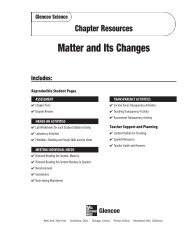chap06 - Learning Services Home
chap06 - Learning Services Home
chap06 - Learning Services Home
- No tags were found...
Create successful ePaper yourself
Turn your PDF publications into a flip-book with our unique Google optimized e-Paper software.
Temperature■ Distinguish between temperatureand heat.■ Identify important uses of heat.■ Explain how heat moves.The flow of heat warms Earth,produces weather, cooks your food,and warms and cools your home.Review Vocabularymolecule: a particle formed whentwo or more atoms bond togetherNew Vocabularytemperature• heatconduction• convectionradiationFigure 11 In gases, atoms ormolecules are free to move in alldirections.TemperatureWhat’s today’s temperature? If you looked at a thermometer,listened to a weather report on the radio, or saw a weather mapon television, you probably used the air temperature to help youdecide what to wear. Some days are so hot you don’t need ajacket. Others are so cold you want to bundle up.Hot and cold are words used in everyday language to describetemperature. However, they are not scientific words becausethey mean different things to different people. A summer daythat seems hot to one person might seem just right to another.If you grew up in Texas but moved to Minnesota, you might findthe winters unbearably cold. Have you ever complained that aclassroom was too cold when other students insisted that it wastoo warm?Temperature and Kinetic Energy What is temperature?Remember that any material or object is made up of atoms ormolecules. These particles are moving constantly, even if theobject appears to be perfectly still. Every object you can thinkof—your hand, the pencil on your desk, or even the desktop—contains particles that are in constant motion. In solids, liquids,and gases particles do not move in a single direction. Insteadthey move in all directions. In a gas, particles are far apart andcan move, as shown in Figure 11.In liquids, atoms are close togetherand can’t move as far as in a gas. Insolids, particles are bound moretightly together than in a liquid.Instead of moving freely as shownin Figure 11, atoms or molecules ina solid vibrate back and forth. Themotion of particles in all directionsin solids, liquids, and gases is calledrandom motion. Because the particlesare moving, they have kineticenergy. The faster the particles aremoving, the more kinetic energythey have.170 CHAPTER 6 Energy














